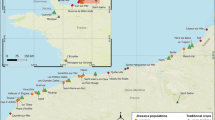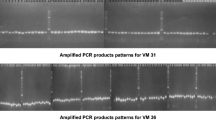Abstract
Wild taxa in Brassica oleracea L. play an important role to improve cultivated crops, but the genomic relationships between wild and cultivated forms have not been well clarified. An overall survey of genomic relationships among 39 accessions covering 10 wild and 7 cultivared types in B. oleracea was performed using amplified fragment length polymorphism and simple sequence repeat. The cultivated types were clustered together with B. oleracea ssp. oleracea, B. incana, B. bourgeaui, B. montana, B. cretica and B. hilarionis, while 4 wild taxa from Sicily, B. rupestris, B. insularis, B. macrocarpa and B. villosa formed the other group. It implies the low possibility that current B. oleracea crops originated in Sicily.



Similar content being viewed by others
References
Allender CJ, Allainguillaume J, Lynn J, King GJ (2007) Simple sequence repeats reveal uneven distribution of genetic diversity in chloroplast genome of Brassica oleracea L. and (n = 9) wild relatives. Theor Appl Genet 114(4):118–609. doi:10.1007/s00122-006-0461-5
Dias JS (1995) Genetic relationships of Portugese coles and other close related Brassica genotypes using nuclear RFLPs. Genet Resour Crop Evol 42:363–369. doi:10.1007/BF02432140
Ellis PR, Pink DAC, Barber NE, Mead A (1999) Identification of high levels of resistance to cabbage root fly, Delia radicum, in wild Brassica species. Euphytica 110:207–214. doi:10.1023/A:1003752801143
Falush D, Stephens M, Pritchard JK (2007) Inference of population structure using multilocus genotype data: dominant markers and null alleles. Mol Ecol Notes 7:574–578. doi:10.1111/j.1471-8286.2007.01758.x
Geraci A, Divaret I, Raimondo FM, Chèvre AM (2001) Genetic relationships between Sicilian wild populations of Brassica analysed with RAPD markers. Plant Breed 120:193–196
Gladis T, Hammer K (2001) Nomenclatural note on the Brassica oleracea-group. Genet Resour Crop Evol 48:7–11
Gómez-Campo C (1999) Biology of Brassica coenospecies. Elsevier, The Netherlands
Harberd DJ (1976) Cytotaxonomic studies of Brassica and related genera. In: Vaughan JG, Macleod AJ, Jones BMG (eds) The biology and chemistry of the Cruciferae. London
Kianian SF, Quiros CF (1992) Trait inheritance, fertility, and genomic relationships of some n = 9 Brassica species. Genet Resour Crop Evol 39:165–175. doi:10.1007/BF00051930
Lannér C (1998) Relationships of wild Brassica species with chromosome number 2n = 18, based on comparison of the DNA sequence of the chloroplast intergenic region between trnL(UAA) and trnF(GAA). Can J Bot 76:228–237
Lannér C, Bryngelsson T, Gustafsson M (1997) Relationships of wild Brassica species with chromosome number 2n = 18, based on RFLP studies. Genome 40:302–308. doi:10.1111/j.1439-0523.2001.tb01985.x
Lázaro A, Aguinagalde I (1996) Phylogenetic relationships between the wild taxa of the Brassica oleracea L. group (2n = 18) using random amplified polymorphic DNA assay. Sci Hortic 65:219–227. doi:10.1016/0304-4238(96)00894-1
Lázaro A, Aguinagalde I (1998a) Genetic diversity in Brassica oleracea L. (Cruciferae) and wild relations (2n = 18) using RAPD markers. Ann Bot 82:829–833
Lázaro A, Aguinagalde I (1998b) Genetic diversity in Brassica oleracea L. (Cruciferae) and wild relations (2n = 18) using isozymes. Ann Bot 82:821–828
Louarn S, Torp AM, Holme IB, Andersen SB, Jensen BD (2007) Database derived microsatellite markers (SSRs) for cultivar differentiation in Brassica oleracea. Genet Resour Crop Evol 54:1717–1725. doi:10.1007/s10722-006-9181-6
Mei J, Li J, Li Q, Yang X, Yin J, Cai D, Frauen M, Qian W (2008) Identification of Sclerotinia sclerotiorum resistance within Brassica oleracea. ISHS Brassica Symposium, 16th Crucifer Genetics Workshop, Norway, pp 81
Mithen RF, Magrath R (1992) Glucosinolates and resistance to Leptosphaeria maculans in wild and cultivated Brassica species. Plant Breed 108:60–68
Mithen RF, Lewis BG, Heaney RK, Fenwick GR (1987) Resistance of leaves of Brassica species to Leptosphaeria maculans. Trans Br Mycol Soc 88:525–531
Nei M, Li WH (1979) Mathematical model for studying genetic variation in terms of restriction endouncleases. Proc Natl Acad Sci USA 76:5269–5273
Panda S, Martín JP, Aguinagalde I (2003) Chloroplast and nuclear DNA studies in a few members of the Brassica oleracea L. group using PCR-RFLP and ISSR-PCR markers: a population genetic analysis. Theor Appl Genet 106:1122–1128. doi:10.1007/s00122-002-1134-7
Perrino P, Hammer K (1985) Collection of landraces of cultivated plants in south Italy. Kulturpflanze 33:225–236
Ramsey AD, Ellis PR (1994) Resistance in wild Brassicas to the cabbage whitefly, Aleyrodes proletella. ISHS Brassica Symposium, 9th Crucifer Genetics Workshop, Lisbon, Portugal, pp 32
Rohlf FJ (1997) NTSYS-PC 2.1. Numerical taxonomy and multivariate analysis system. Exeter Software, Setauket
Saghai-Maroof MA, Soliman KM, Jorgensen RA, Allard RW (1984) Ribosomal DNA spacer-length polymorphism in barley: mendelian inheritance, chromosomal location and population dynamics. Proc Natl Acad Sci USA 81:8014–8018
SAS Institute (1992) SAS technical report. SAS statistics software: changes and enhancements. Release 6.07. SAS Institute, Cary
Sneath PHA, Sokal RR (1973) Numerical taxonomy: the principles and practice of numerical classification. Freeman, San Francisco
Snogerup S (1980) The wild forms of the Brassica oleracea group (2n = 18) and their possible relations to the cultivated ones. In: Tsunoda S, Hinata K, Gómez-Campo C (eds) Brassica crop and wild allies, biology and breeding. Japan Science Press, Tokyo, pp 121–132
Snogerup S, Gustafsson M, von Bothmer R (1990) Brassica sect. Brassica (Brassicaceae) I. Taxonomy and variation. Willdenowia 19:271–365
Song KM, Osborn TC, Williams PH (1990) Brassica taxonomy based on nuclear restriction fragment length polymorphisms (RFLPs). 3. Genome relationships in Brassica and related genera and the origin of B. oleracea and B. rapa (syn. campestris). Theor Appl Genet 79:497–506. doi:10.1007/BF00226159
Thompson KF (1976) Cabbages, kales etc., Brassica oleracea (Cruciferae). In: Simmonds NW (ed) Evolution of crop plants. Longman Group Ltd, London
Von Bothmer R, Gustafsson M, Snogerup S (1995) Brassica sect. Brassica (Brassicaceae) II. Inter- and intraspecific crosses with cultivars of B. oleracea. Genet Resour Crop Evol 42:165–178. doi:10.1007/BF02539520
Vos P, Hogers R, Bleeker M et al (1995) AFLP: a new technique for DNA fingerprinting. Nucleic Acids Res 23:4407–4414
Yap IV, Nelson RJ (1996) WINBOOT, a program for performing bootstrap analysis of binary data to determine the confidence limits of UPGMA-based dendrograms. International Rice Research Institute, Manila
Zhang J, Guo W, Zhang TZ (2002) Molecular linkage map of allotetraploid cotton (Gossypium hirsutum L. × Gossypium barbadense L.) with a haploid population. Theor Appl Genet 105:1166–1174. doi:10.1007/s00122-002-1100-4
Acknowledgments
We thank CGN in Netherlands, IPK in Germany, UPM in Spain, Prof. Snogerup S from UL in Sweden and Prof. Quiros C from UC Davis for kind supports in collection of materials. It is financially supported by NPZ Company, Natural Science Foundation Project of CQ (2007BB1362), 863 Project (2006AA10ZIE6) and Ministry of Education of China and Ministry of Personnel of China Fund to W. Qian.
Author information
Authors and Affiliations
Corresponding authors
Rights and permissions
About this article
Cite this article
Mei, J., Li, Q., Yang, X. et al. Genomic relationships between wild and cultivated Brassica oleracea L. with emphasis on the origination of cultivated crops. Genet Resour Crop Evol 57, 687–692 (2010). https://doi.org/10.1007/s10722-009-9504-5
Received:
Accepted:
Published:
Issue Date:
DOI: https://doi.org/10.1007/s10722-009-9504-5




